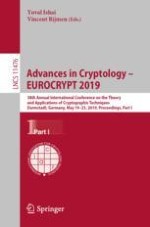2019 | OriginalPaper | Chapter
Linear Equivalence of Block Ciphers with Partial Non-Linear Layers: Application to LowMC
Authors : Itai Dinur, Daniel Kales, Angela Promitzer, Sebastian Ramacher, Christian Rechberger
Published in: Advances in Cryptology – EUROCRYPT 2019
Publisher: Springer International Publishing
Activate our intelligent search to find suitable subject content or patents.
Select sections of text to find matching patents with Artificial Intelligence. powered by
Select sections of text to find additional relevant content using AI-assisted search. powered by
